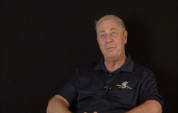5:10 | He was married and in graduate school but when his deferment no longer protected him from the draft, George Ferkes enlisted in the Air Force and learned to fly. He was assigned as a forward air controller and began training for Vietnam.
Keywords : George Ferkes 90 Day Wonder flight school Lubbock TX Vietnam Forward Air Controller (FAC) Cessna O-2 Skymaster survival school Fort Walton Beach FL Philippines Negrito

The base was at Quang Tri, up near the DMZ. George Ferkes was a new forward air controller, or FAC, whose job was to support the South Vietnamese forces in the area and their American advisors.
Operation Lam Son 719 was an attempt by the South Vietnamese forces to cut the Ho Chi Minh trail and disrupt the supply of Communist forces in the South. George Ferkes supported them by calling in air strikes where needed. The campaign went so badly that, eventually, he was calling in strikes to destroy abandoned armor.
Forward air controller George Ferkes marked his targets with white phosphorus rockets that put out a lot of smoke. He also had a Starlight scope, the first practical night vision device, but it was bulky and hard to use. He describes one memorable mission which had him supporting an ARVN unit near the DMZ which was overrun by the enemy.
When he returned from Vietnam, George Ferkes is fairly sure he saw his old hooch burning on the television when Quang Tri fell. After a couple of years he leapt at the chance to join a special ops outfit, even though, at the time, there was little interest in those units.
Special forces went through a bit of a renaissance after the failed rescue of the hostages in Iran. Never again would US special operations be caught flat footed and unprepared. Pilot George Ferkes was a part of that mission and it provided him with a purpose that guided him through the rest of his career.
There is a always lot of dry humor in military life. Special operations pilot George Ferkes recalls some moments from his career that made him laugh.
George Ferkes pays tribute to leaders who inspired him during his career in Air Force special ops. His part in the Iran hostage crisis became a catalyst for the rest of his career which he dedicated to the build up of special forces.
When the Iran hostage crisis happened, President Carter asked the joint chiefs if there was any way they could be rescued. This set off a mad scramble to put together a multi-branch operation and Air Force special ops pilot George Ferkes was right in the middle of it.
There was some good intelligence available during the planning of the Iran hostage rescue attempt. For instance, pilot George Ferkes knew that an aircraft could easily avoid the radar at the border. That was not the problem, though, once the effort got underway.
Operation Eagle Claw was the name of the attempt by US Special Forces to rescue the hostages from the embassy in Iran. The mission was aborted because of mechanical failures in helicopters and then turned tragic when eight men died in a fiery crash. Pilot George Ferkes was part of that team and he describes the events from his perspective.
In the aftermath of the debacle at Desert One, an effort to plan and execute another mission to rescue the hostages in Iran got under way. Air Force special ops pilot George Ferkes recalls that new tactics and equipment were developed that served as the blueprint for the revitalization of special operations units throughout the military.
Operation Eagle Claw was a pivotal moment in Special Operations history. Unconventional warfare had been ignored after the Vietnam War and three veterans of that conflict, who were also deeply involved with the attempt to rescue the hostages in Iran, reveal the inside story of the planning and tragic outcome. George Ferkes, Roland Guidry and Keith Nightingale each offer a unique perspective on the events.